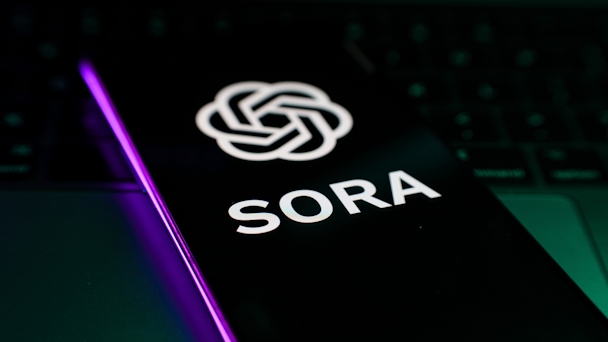While hype envelops OpenAI’s genAI video platform Sora, some warn against commercial use
Some say Sora will supercharge marketing and commercial creativity. Others are less convinced.

While some marketers are bullish on Sora's commercial potential, others are saying, "Not so fast." / Adobe Stock
As part of its ‘ship-mas’ product push ahead of the holidays, ChatGPT parent OpenAI on Monday released Sora, its highly anticipated video-generation platform, which was previously available only to a select group of testers.
It’s a launch that some experts believe could greatly disrupt commercial creativity.
After iterating for a number of months, OpenAI has developed an enhanced version of the tool, dubbed Sora Turbo, available now via Sora.com for ChatGPT Plus and Pro users in the US and some other markets. Sora Turbo promises faster video creation capabilities, enabling users to produce realistic, 1080p resolution videos that are up to 20 seconds long from text prompts. The model supports a variety of aspect ratios and allows users to customize content with their own assets or create entirely new visuals.
The product also includes a ‘storyboard tool’ that gives users the ability to more precisely tailor each frame in a video. Plus, community-driven feeds are rolling out within the platform to showcase user-generated content.
“We hope this early version of Sora will enable people everywhere to explore new forms of creativity, tell their stories, and push the boundaries of what’s possible with video storytelling,” the company said in a blog post announcing the release.
The company said that Sora Turbo is “much faster” than the preview of Sora released to limited users in February, and noted that the team is working to make the tool more affordable in the future.
The company also addressed growing concerns about transparency and disclosures around AI-generated content. It explained that Sora-made videos include metadata for the Coalition for Content Provenance and Authenticity (C2PA) technical standard, as well as visible, by-default watermarks. Plus, the company has built an internal search function that uses technical parameters to identify a video’s provenance. All of these features can, in theory, be used to determine whether a video was developed via Sora, helping to tamp down on the spread of misinformation online and potentially mitigate intellectual property disputes.
OpenAI has also implemented content guardrails on Sora – blocked content includes child sexual abuse materials and sexual deepfakes.
Sora is not yet available in the UK or most of Europe.
Want to go deeper? Ask The Drum
The believers make their case
Experts in marketing, production and communications are somewhat divided on the degree to which Sora might unseat traditional creative development.
At minimum, the tool’s capabilities appear to have evolved beyond what was showcased in a highly ridiculed Toys R Us ad in June.
And some are extremely bullish on its potential.
“Sora is transforming how we approach commercial creativity and marketing,” says Nikola Baldikov, founder and CEO at Inbound Blogging, an SEO-focused content firm. “It’s making high-quality content creation more accessible than ever. It cuts out the need for expensive pre-production processes and professional equipment, which opens doors for smaller brands and creators who didn’t have the resources before.”
The sentiment is echoed by Dev Nag, CEO of support automation firm QueryPal, who says, “Just as stock photography transformed print advertising decades ago, Sora and similar AI video tools will make high-quality video content creation more accessible and dramatically faster – and because creators can generate exactly what they envision rather than searching through existing assets, the creative possibilities expand exponentially.”
Advertisement
Nag expects that ongoing improvements to Sora’s capabilities will have long-term implications for the economics and operations of advertising and marketing. For now, he says, we’re entering a “first wave,” where we’ll see streamlined day-to-day production of assets like social media ads and product demos.
But in his perspective, the rapid clip at which AI capabilities are advancing “suggests that any current technical limitations will largely disappear within 18 to 24 months” – meaning that, before long, we’ll hit a “second wave.” This era, he predicts, will see expanded use cases for video-generation technologies like Sora. “Creatives and agencies [will] start leveraging this technology as a creative partner, rapidly prototyping ideas and exploring creative directions at unprecedented speed and scale,” he says.
Sora’s capabilities may not just reshape how creative teams work – but could also reshape creative teams themselves. Baldikov expects that streamlined ideation and drafting could free teams up to focus more on high-level storytelling and strategy – but it could also replace jobs. “If tasks like concept visualization and quick content drafts can now be done in minutes, you simply don’t need to have a large team to perform them,” he says.
Advertisement
The skeptic’s view
Though Sora’s arrival comes with much fanfare, competing in an increasingly crowded generative AI landscape won’t necessarily be a cakewalk.
That’s because a handful of other text-to-video models have already established themselves as formidable competitors. Chief among them is Runway. Known for its seamless integration with creative workflows, high-quality outputs and emphasis on artistic freedom, Runway has also positioned itself as a tool for creative professionals such as filmmakers and designers.
And some experts believe OpenAI may have already missed a critical window of opportunity to inspire Sora adoption among entertainment, production and advertising shops.
“The ‘prosumer’ and ‘pro’ user segments include film studios, advertising agencies, VFX and animation studios – all of these are already being served well by companies like Runway, which has large customers across all these segments,” says Sanja Partalo, co-founder and general partner at S4S Ventures, which invests in companies at the intersection of marketing, advertising and media. She also flags Autodesk-owned Wonder Dynamics as a leader in generative animation.
Suggested newsletters for you
And beyond the competitive market of text-to-video generation, Sora may still suffer technical limitations. Beta users noted earlier this year that, despite the sophisticated imagery, the model ran into visual missteps common in AI-generated imagery and videos – sometimes failing to depict hands with the correct number of fingers, for example.
Though OpenAI has been working for months to iron out technical issues like these, the company acknowledged in its blog post yesterday that the product remains imperfect. “The version of Sora we are deploying has many limitations,” OpenAI wrote. “It often generates unrealistic physics and struggles with complex actions over long durations.”
Some marketers remain unconvinced by any technical advancements that Sora may have made in the months since it was released in beta.
“Sora is great for bogus, bastardized, nonsensical, dreamlike sequences,” says Bernard Meyer, senior director of creative and communications at Omnisend, an e-commerce and email marketing firm.
Speaking more generally, Meyer suggests that AI-generated video tends to fall short when it comes to “creating visual consistency” and says that humans can frequently pinpoint these visual inconsistencies. “When even the smallest detail is ‘off,’ we can spot it and it will distract us from the focus or purpose of the video,” he says.
Technical limitations aside, Sora-made videos may fall flat for want of greater cultural context and human emotion, says Daria Shevchenko, CMO at Snov.io, which helps firms automate their marketing efforts. In her view, no amount of technical innovation will translate seamlessly into “content that will resonate with real people.” She says, “Only people know how to do that.”
Weighing the legal and ethical landmines
Sora’s public debut has sparked concerns over legal and ethical issues that could complicate the platform’s widespread adoption.
For one, while Sora may represent a breakthrough in AI-generated content, it also shines a spotlight on consumers’ and lawmakers’ growing concerns about authenticity, provenance and intellectual property rights.
Today, the need for more explicit disclosures about whether a piece of content was made or augmented with AI is growing, evidenced by an explosion of AI-generated misinformation this year – from realistic faux images of young hurricane survivors to a Soviet-era-inspired image portraying Kamala Harris as a communist.
OpenAI has said that Sora adheres to the Coalition for Content Provenance and Authenticity (C2PA) specifications. Founded in 2021 by a cohort including Adobe, BBC, Intel and Microsoft, C2PA has established an open-access technical standard that can be used to verify a piece of content’s origins and authenticity.
Nonetheless, some experts remain concerned due to OpenAI’s lack of transparency around its training and governance practices. The company has not disclosed the specific datasets used to train Sora. Like many other consumer-facing generative AI models, it’s probable that the program was trained on a vast range of publicly available information, which may include work in the public domain, copyrighted materials and other sources. Of course, the possibility that the model was trained on copyrighted work creates potential legal pitfalls for users and for OpenAI.
Brian Sanford, the creative editor and director of post-production at Versus, a production studio, partook in the artist beta, and has had extended access to Sora for the past six months. While he’s been somewhat impressed by the ability to generate longer videos and the visual fidelity of the end product, he remains skeptical about the system’s training. And ultimately, Sanford sees this as a prohibitive hurdle. “Without a clear understanding” of how Sora was trained, he says, “it will be difficult to deploy the system in commercial production.”
The notion is echoed by Terri Walter, managing director of B2B marketing agency SalientMG, who says that Sora is still “far from being a tool we would recommend for commercial use cases.”
She argues that Sora falls short in terms of asset protection and proper governance, making it a potential liability for marketers and advertisers. She urges the industry to keep an eye on OpenAI’s governance practices and remain vigilant in complying with data privacy regulations like the EU’s General Data Protection Regulation and the UK’s Online Safety Act.
Experts remain divided on the extent to which Sora will revolutionize marketing and commercial creativity, but one thing is clear: the influx of AI-generated video in the industry and in the world comes with a plethora of legal and ethical quandaries yet to be fully addressed.
Shortly after its public launch on Monday, OpenAI barred new Sora signups due to high demand.
